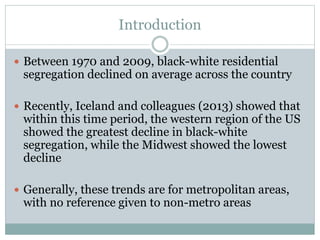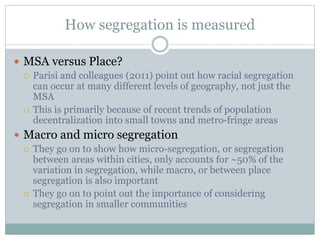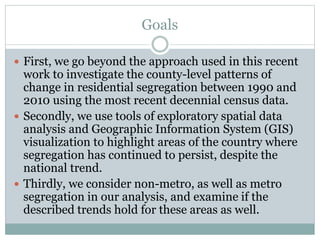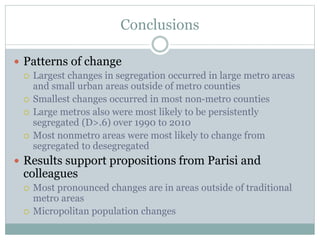Sparks & Sparks Spatiotemporal persistence of residential segregation SSSA 2013
- 1. C O R E Y S . S P A R K S P . J O H N E L L E S P A R K S D E P A R T M E N T O F D E M O G R A P H Y T H E U N I V E R S I T Y O F T E X A S A T S A N A N T O N I O A Spatial Analysis of Changing Segregation Patterns in the United States Between 1990 and 2010
- 2. Introduction ’éŚ Between 1970 and 2009, black-white residential segregation declined on average across the country ’éŚ Recently, Iceland and colleagues (2013) showed that within this time period, the western region of the US showed the greatest decline in black-white segregation, while the Midwest showed the lowest decline ’éŚ Generally, these trends are for metropolitan areas, with no reference given to non-metro areas
- 3. Reasons for Regional Patterns of Residential Segregation ’éŚ Iceland et al (2013) point out that the size of the minority population itself is often associated with higher levels of segregation ’éĪ Also size of the metro area ’éĪ This is especially seen in the NE and MW ’éŚ In other areas, more multi-ethnic populations may serve as a buffer to black-white patterns of segregation ’éĪ Historic patterns of black population migration have also affected the overall temporal trend in segregation ’éŚ Also, patterns of economic activity and growth in housing markets have affected segregation patterns ’éĪ Government, military and higher education decrease segregation ’éĪ Suburbanization also decreases segregation
- 4. How segregation is measured ’éŚ MSA versus Place? ’éĪ Parisi and colleagues (2011) point out how racial segregation can occur at many different levels of geography, not just the MSA ’éĪ This is primarily because of recent trends of population decentralization into small towns and metro-fringe areas ’éŚ Macro and micro segregation ’éĪ They go on to show how micro-segregation, or segregation between areas within cities, only accounts for ~50% of the variation in segregation, while macro, or between place segregation is also important ’éĪ They go on to point out the importance of considering segregation in smaller communities
- 5. Goals ’éŚ First, we go beyond the approach used in this recent work to investigate the county-level patterns of change in residential segregation between 1990 and 2010 using the most recent decennial census data. ’éŚ Secondly, we use tools of exploratory spatial data analysis and Geographic Information System (GIS) visualization to highlight areas of the country where segregation has continued to persist, despite the national trend. ’éŚ Thirdly, we consider non-metro, as well as metro segregation in our analysis, and examine if the described trends hold for these areas as well.
- 6. Data ’éŚ US Decennial Census ’éĪ Summary File 1 ’éĪ 1990, 2000, 2010 ’éĪ Population tabulated by Race ’éĪ Census tract level ’éĪ NHGIS County Shapefile ’āĘ n=3109 counties, 3 time periods
- 7. Methods ’éŚ Calculate two indices of segregation ’éĪ Evenness ŌĆō Dissimilarity Index ’éĪ Exposure ŌĆō Interaction Index ’éŚ Apply Exploratory Spatial Analysis Methods ’éĪ Getis-Ord G* - Examine spatial clustering of high and low values of segregation indices ’éĪ Examine persistence of clustering across time ’éĪ Examine spatial patterns of segregation change between 1990 and 2010
- 8. Spatial Trends in Segregation Dissimilarity
- 9. Spatial Trends in Segregation Dissimilarity
- 10. Spatial Trends in Segregation Dissimilarity 2010 Dissimilarity G*
- 11. Spatial Trends in Segregation Change in Dissimilarity
- 12. Spatial Trends in Segregation Interaction
- 13. Spatial Trends in Segregation Interaction
- 14. Spatial Trends in Segregation Interaction
- 15. Spatial Trends in Segregation Change in Interaction
- 16. Changes in Segregation Across the Urban-Rural Continuum
- 17. Persistence in Segregation Across the Urban- Rural Continuum
- 18. Conclusions ’éŚ Patterns of change ’éĪ Largest changes in segregation occurred in large metro areas and small urban areas outside of metro counties ’éĪ Smallest changes occurred in most non-metro counties ’éĪ Large metros also were most likely to be persistently segregated (D>.6) over 1990 to 2010 ’éĪ Most nonmetro areas were most likely to change from segregated to desegregated ’éŚ Results support propositions from Parisi and colleagues ’éĪ Most pronounced changes are in areas outside of traditional metro areas ’éĪ Micropolitan population changes


















